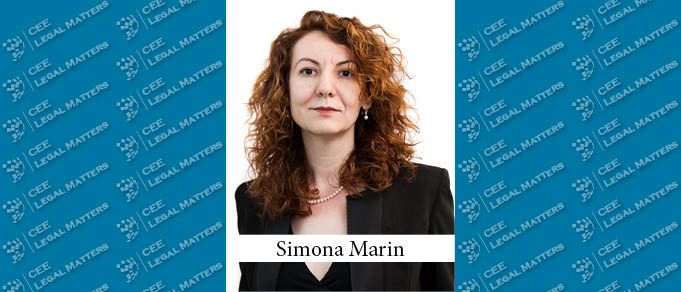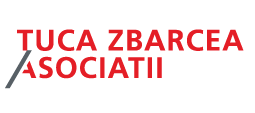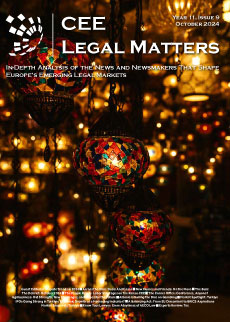Simona Marin is an English- and New York-qualified partner in CMS’s International Finance team in Bucharest, where she focuses on project finance, real estate finance and other financing structures, both syndicated and bilateral, secured and unsecured. Simona has over ten years’ experience advising on a broad range of high-profile financings and projects throughout Central and Eastern Europe.
CEELM: Run us through your background, and how you ended up in your current role with CMS in Romania.
Simona: I was born and raised in Romania until the age of 15, when I went to NY with my mother. So my high school, college, and law school education was completed in the United States. Throughout this time, I always came back to Europe at least once a year and I always believed that the European lifestyle and frame of mind fit me better than that of the United States. At a certain point in my legal career I also spent three years in Athens (as part of CMS) assisting our clients in Greece with their projects in Romania and South East Europe.
CEELM: Was it always your goal to work in Romania?
Simona: Working in Romania was not really a goal for me, but rather a combination of favorable circumstances, as in my last year of law school I met Simon Dayes and a few other partners who at the time were part of the Hayhurst Robinson law firm. Simon suggested I return to Romania when I passed my New York state bar exam. Since I was already thinking that the United States was not really the place for me, and Romanian was my first language, I decided to give it a try, although my decision surprised quite a few people among my friends, my family, and I daresay a few at Hayhurst Robinson. Having a common law background I qualified under English law and have been practicing in CEE for over thirteen years.
CEELM: Tell us briefly about your practice, and how you built it up over the years.
Simona: My practice focuses primarily on assisting banks and other financial institutions on cross-border projects and real estate finance transactions in the CEE region and other developing markets. When I joined Simon and the Hayhurst team in Bucharest in 2005, the Romanian banking and financial market was in its early stages, from a transactional perspective. The international financial institutions like the EBRD and IFC were very present in the market, but the commercial banks were only then starting to make their presence felt. In 2006, when Hayhurst Robinson merged with CMS Cameron McKenna, the major players in the banking community were the Greek banks, who were all looking to lend into Romania on a cross-border structure, financing the development and operation of commercial real estate assets. Most cross-border transactions were done under English law and I was able to put both my degree and my Greek language skills to good use in developing a strong relationship with the Greek banks. Over time the Greek banks started instructing the Bucharest Banking and Finance team in all of their international transactions in South East Europe. At the same time we began doing more project finance work for the international financial institutions. And once the crisis hit and the Greek banks were required to leave the CEE markets, they were swiftly replaced by Austrian and German banks looking to plug the gap. Today, my biggest clients are Raiffeisen International Bank, Erste Group Bank AG, and UniCredit Bank, out of Vienna, Milan, and (via their local subsidiaries) throughout CEE, followed very closely by the EBRD, BSTDB, and IFC.
The key to growing my practice has been the ability to offer clients representation under English law and transaction management for CEE transactions from within CEE, backed by local law advice, all within the same law firm. I and the Bucharest banking team are involved in transactions across the region and work with the CMS offices in each of those countries to offer seamless cooperation.
CEELM: How would clients describe your style?
Simona: Relaxed and easy to communicate with, but business–minded and committed to finding solutions with the client.
CEELM: There are obviously many differences between the American and Romanian judicial systems and legal markets. What idiosyncrasies or differences stand out the most?
Simona: Romania is a developing market with a young judiciary, whereas the United States is a developed market with hundreds of years of undisturbed legal precedent. This makes Romania and its CEE neighbors a very exciting platform for practicing law, because almost no transaction is the same – even the so-called cookie-cutters. It means that apart from offering sound legal advice, lawyers have the opportunity to assist clients with structuring transactions to overcome potential legal uncertainties. Another very important difference is that Romania is a civil law jurisdiction (meaning its legal system is based on codified statutes) whereas the US and the UK are common law jurisdictions where case law (meaning published judicial opinions) are of primary importance. However, the type of transactions my team and I undertake more often than not involve both types of law, and it is a very interesting exercise for us to compare and contrast how certain principles established under common law, would or might be interpreted in Romania or other civil law jurisdictions.
CEELM: How about the cultures? What differences strike you as most resonant and significant?
Simona: I think the United States is very often described as a melting pot of cultures, but I rather think of it as a salad bowl, a country which is ethnically and racially diverse, and where the various cultural elements compliment and set each other off, rather than blend into one single culture. I think by comparison Romania is a rather homogenous culture, heavily influenced by its history and geography. It’s fascinating seeing these two cultures through the eyes of one another. I think probably the formative years I spent in the US have made me appreciate aspects of the Romanian culture on which I had not focused on before – and vice-versa of course. Actually I think nowadays there are lots of similarities between the two rather than stark contrasts – especially as Romania is becoming increasingly open to international influence, having become, in certain areas, a cultural hub for CEE.
CEELM: What particular value do you think a senior expatriate lawyer in your role adds, both to a firm and to its clients?
Simona: I think one of the most important aspects for clients in our practice area is the ability to manage a transaction from inception to completion. Someone who undertakes cross-border transactions in several jurisdictions can bring to the table the experience of several jurisdictions and solutions developed over time in those jurisdictions. I think another important element for our clients is consistency, by which I mean the knowledge that whether a transaction in in Romania, Poland, Ukraine, Serbia, Germany, or Cyprus, the level of know-how and expertise is the same. A lead counsel who has acted in many jurisdictions and has managed several teams will be able to pull a transaction together in the same way across all of those jurisdictions. For a firm like CMS, having someone with this kind of experience and background is important because it provides valuable know-how transfer. I work with each of our local CEE teams as well as our teams in Western Europe and beyond and I am able to transfer information and experience from one team to another and from one transaction to another. This is an invaluable tool for me and I trust it is of great to both my clients and my colleagues.
CEELM: Do you have any plans to move back to the US?
Simona: While I am extremely grateful for the many opportunities, personal and professional growing up in the US has given me, I do not see myself moving back to the US. But one should probably never say never (laughs).
CEELM: Outside of Romania, which CEE country do you enjoy visiting the most, and why?
Simona: My favorite country to visit is Greece, not just because of my family connections there (my husband is from Crete), but because of the incredible natural beauty of the country, the welcoming culture, and the incredible history of the people.
CEELM: What’s your favorite place to take visitors in Bucharest?
Simona: Mogosoaia Palace, on the north edge of Bucharest – a place steeped in history and culture, as well as a lovely park where you can spend a wonderful summer Sunday afternoon.
This Article was originally published in Issue 6.5 of the CEE Legal Matters Magazine. If you would like to receive a hard copy of the magazine, you can subscribe here.



